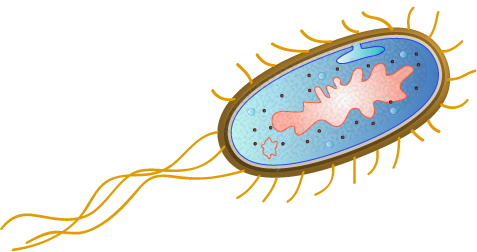|
Aquatic Locomotion
Aquatic locomotion or swimming is biologically propulsion , propelled motion through a liquid medium. The simplest propulsive systems are composed of cilia and flagella. Swimming has evolved a number of times in a range of organisms including arthropods, fish, molluscs, amphibians, reptiles, birds, and mammals. Evolution of swimming Swimming evolved a number of times in unrelated lineages. Supposed jellyfish fossils occur in the Ediacaran, but the first free-swimming animals appear in the Early to Middle Cambrian. These are mostly related to the arthropods, and include the Anomalocarididae , Anomalocaridids, which swam by means of lateral lobes in a fashion reminiscent of today's cuttlefish. Cephalopods joined the ranks of the active swimmers (nekton) in the late Cambrian, and chordates were probably swimming from the Early Cambrian. Many terrestrial animals retain some capacity to swim, however some have returned to the water and developed the capacities for aquatic locomotio ... [...More Info...] [...Related Items...] OR: [Wikipedia] [Google] [Baidu] |
Diving Bird
Diving birds are birds which plunge into the water to catch fish or other prey. Description Such birds may enter the water from flight, such as pelicans, gannets and tropicbirds; or they may dive from the surface of the water, such as the diving ducks, cormorants and penguins. It is theorized that they evolved from birds already adapted for aquatic locomotion, swimming that were equipped with such adaptations as Bird feet and legs#Webbing and lobation, lobed or webbed feet for Animal locomotion, propulsion. Foot-propelled diving birds Some diving birds, for example the extinct Hesperornithes of the Cretaceous Period, propelled themselves with their feet. They were large, streamlined, and flightless birds with teeth for grasping slippery prey. Today, cormorants (family Phalacrocoracidae), loons (Gaviidae), and grebes (Podicipedidae) are the major groups of foot-propelled diving birds. Wing-propelled diving birds Other diving birds are wing-propelled; penguins (Sphenisciformes), dip ... [...More Info...] [...Related Items...] OR: [Wikipedia] [Google] [Baidu] |
Cuttlefish
Cuttlefish, or cuttles, are Marine (ocean), marine Mollusca, molluscs of the order (biology), suborder Sepiina. They belong to the class (biology), class Cephalopoda which also includes squid, octopuses, and nautiluses. Cuttlefish have a unique internal mollusc shell, shell, the cuttlebone, which is used for control of buoyancy. Cuttlefish have large, W-shaped pupils, eight Cephalopod arm, arms, and two tentacles furnished with :wikt:denticulate, denticulated suckers, with which they secure their prey. They generally range in size from , with Cephalopod size, the largest species, the giant cuttlefish (''Sepia apama''), reaching in mantle (mollusc), mantle length and over in mass. Cuttlefish eat small molluscs, crabs, shrimp, fish, octopuses, worms, and other cuttlefish. Their predators include dolphins, larger fish (including sharks), seals, seabirds, and other cuttlefish. The typical life expectancy of a cuttlefish is about 1–2 years. Studies are said to indicate cuttlefis ... [...More Info...] [...Related Items...] OR: [Wikipedia] [Google] [Baidu] |
Archaea
Archaea ( ) is a Domain (biology), domain of organisms. Traditionally, Archaea only included its Prokaryote, prokaryotic members, but this has since been found to be paraphyletic, as eukaryotes are known to have evolved from archaea. Even though the domain Archaea Cladistics, cladistically includes eukaryotes, the term "archaea" (: archaeon , from the Greek "ἀρχαῖον", which means ancient) in English still generally refers specifically to prokaryotic members of Archaea. Archaea were initially Taxonomy (biology), classified as bacteria, receiving the name archaebacteria (, in the Archaebacteria Kingdom (biology), kingdom), but this term has fallen out of use. Archaeal cells have unique properties separating them from Bacteria and Eukaryote, Eukaryota. Archaea are further divided into multiple recognized phylum, phyla. Classification is difficult because most have not been Isolation (microbiology), isolated in a laboratory and have been detected only by their Gene, gene s ... [...More Info...] [...Related Items...] OR: [Wikipedia] [Google] [Baidu] |
Bacterial Motility
Bacterial motility is the ability of bacteria to motility, move independently using metabolic energy. Most motility mechanisms that evolved among bacteria also evolved Parallel evolution, in parallel among the archaea. Most rod-shaped bacteria can move using their own power, which allows colonization of new environments and discovery of new resources for survival. Bacterial movement depends not only on the characteristics of the medium, but also on the use of different appendages to propel. Swarming and swimming movements are both powered by flagella, rotating flagella. Whereas Swarming motility, swarming is a multicellular 2D movement over a surface and requires the presence of surfactants, #Swimming, swimming is movement of individual cells in liquid environments. Other types of movement occurring on solid surfaces include twitching, gliding and sliding, which are all independent of flagella. Twitching motility, Twitching depends on the extension, attachment to a surface, and ... [...More Info...] [...Related Items...] OR: [Wikipedia] [Google] [Baidu] |
Microorganism
A microorganism, or microbe, is an organism of microscopic scale, microscopic size, which may exist in its unicellular organism, single-celled form or as a Colony (biology)#Microbial colonies, colony of cells. The possible existence of unseen microbial life was suspected from antiquity, with an early attestation in Jain literature authored in 6th-century BC India. The scientific study of microorganisms began with their observation under the microscope in the 1670s by Anton van Leeuwenhoek. In the 1850s, Louis Pasteur found that microorganisms caused food spoilage, debunking the theory of spontaneous generation. In the 1880s, Robert Koch discovered that microorganisms caused the diseases tuberculosis, cholera, diphtheria, and anthrax. Microorganisms are extremely diverse, representing most unicellular organisms in all three domains of life: two of the three domains, Archaea and Bacteria, only contain microorganisms. The third domain, Eukaryota, includes all multicellular o ... [...More Info...] [...Related Items...] OR: [Wikipedia] [Google] [Baidu] |
Microswimmer
A microswimmer is a microscopic object with the ability to move in a fluid environment. #Natural microswimmers, Natural microswimmers are found everywhere in the natural world as biological microorganisms, such as bacteria, archaea, protists, sperm, and microanimals. Since the turn of the millennium, there has been increasing interest in manufacturing #Synthetic microswimmers, synthetic and biohybrid microswimmers. Although only two decades have passed since their emergence, they have already shown promise for various biomedical and environmental applications. Given the recent nature of the field, there is yet no consensus in the literature for the nomenclature of the microscopic objects this article refers to as "microswimmers". Among the many alternative names such objects are given in the literature, microswimmers, microscale swimmers, micro/nanorobots and micro/nanomotors are likely the most frequently encountered. Other common terms may be more descriptive, including informat ... [...More Info...] [...Related Items...] OR: [Wikipedia] [Google] [Baidu] |
Doggy Paddle
The dog paddle or doggy paddle is a simple swimming style. It is characterized by the swimmer lying on their chest and moving their hands and legs alternately in a manner reminiscent of how dogs and other quadrupedal mammals swim. It is effectively a "trot" in water, instead of land. It was the first swimming stroke used by ancient humans, believed to have been learned by observing animals swim. Prehistoric cave paintings in Egypt show figures doing what appears to be the dog paddle. It is often the first swimming stroke used by young children when they are learning to swim. The dog paddle has also been taught as a military swimming stroke when a silent stroke is needed - since neither arms nor legs break the surface. See also * Human swimming * Front crawl * Breaststroke Breaststroke is a human swimming, swimming style in which the swimmer is on their chest and the torso does not rotate. It is the most popular recreational style due to the swimmer's head being out of ... [...More Info...] [...Related Items...] OR: [Wikipedia] [Google] [Baidu] |
Last Common Ancestor
A most recent common ancestor (MRCA), also known as a last common ancestor (LCA), is the most recent individual from which all organisms of a set are inferred to have descended. The most recent common ancestor of a higher taxon is generally assumed to have been a species. The term is also used in reference to the ancestry of groups of genes (haplotypes) rather than organisms. The ancestry of a set of individuals can sometimes be determined by referring to an established pedigree, although this may refer only to patrilineal or matrilineal lines for sexually-reproducing organisms with two parents, four grandparents, etc. However, in general, it is impossible to identify the exact MRCA of a large set of individuals, but an estimate of the time at which the MRCA lived can often be given. Such ''time to most recent common ancestor'' (''TMRCA'') estimates can be given based on DNA test results and established mutation rates as practiced in genetic genealogy, or by reference to a non- ... [...More Info...] [...Related Items...] OR: [Wikipedia] [Google] [Baidu] |
Saci (Brazilian Folklore)
Saci ( ) is a character in Brazilian folklore. He is a one-legged black man, who smokes a pipe and wears a magical red cap that enables him to disappear and reappear wherever he wishes (usually in the middle of a dirt devil). Considered an annoying prankster in most parts of Brazil, and a potentially dangerous and malicious creature in others, he nevertheless grants wishes to anyone who manages to trap him or steal his magic cap. Legend says that a person can trap a Saci inside a bottle when he is in the form of a dust devil (see Fig. right where he is portrayed in the center of the whirlwind). The Saci legend is seen as a combination of native Tupi lore with African-Brazilian and European myth or superstition combined into it. Also, much of the currently told folklore about the Saci is traceable to what write Monteiro Lobato collected and published in 1917–1918, and the children's book version he created and published in 1921. According to present-day folklore, this genie ... [...More Info...] [...Related Items...] OR: [Wikipedia] [Google] [Baidu] |
University Of The Witwatersrand
The University of the Witwatersrand, Johannesburg (), commonly known as Wits University or Wits, is a multi-campus Public university, public research university situated in the northern areas of central Johannesburg, South Africa. The university has its roots in the mining industry, as do Johannesburg and the Witwatersrand in general. Founded in 1896 as the South African School of Mines in Kimberley, South Africa, Kimberley, it is the third oldest South African university in continuous operation. The university has an enrollment of 37,295 students as of 2025, of which approximately 20 percent live on campus in the university's 17 residences. 63 percent of the university's total enrollment is for Undergraduate education, undergraduate study, with 35 percent being Postgraduate education, postgraduate and the remaining 2 percent being Occasional Students. The university has, as of 2024, an acceptance rate of approximately 4.5%, having received 140,000 applications but only having a ... [...More Info...] [...Related Items...] OR: [Wikipedia] [Google] [Baidu] |
Center For Academic Research And Training In Anthropogeny
The Center for Academic Research and Training in Anthropogeny (CARTA) is a center at the University of California, San Diego (UC San Diego). Formally established in 2008, CARTA is a collaboration between faculty members of UC San Diego main campus, the University of California, San Diego School of Medicine, the Salk Institute for Biological Studies, and interested scientists at other institutions from around the world. CARTA was formed in order to promote transdisciplinary research into anthropogeny - the study of human origins - drawing on methods from a number of traditional disciplines spanning the humanities, social, biomedical, biological, computational & engineering and physical & chemical sciences. History of CARTA Before CARTA was established as a UC San Diego-recognized center, a multidisciplinary effort to study human origins had already been underway in the La Jolla area for over a decade, coordinated by the then "UCSD Project for Explaining the Origin of Humans" (P ... [...More Info...] [...Related Items...] OR: [Wikipedia] [Google] [Baidu] |







